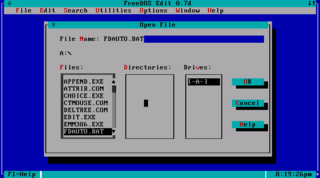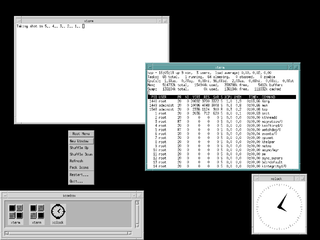
An operating system (OS) is system software that manages computer hardware and software resources and provides common services for computer programs.

GNUstep is a free software implementation of the Cocoa Objective-C frameworks, widget toolkit, and application development tools for Unix-like operating systems and Microsoft Windows. It is part of the GNU Project.
MLDonkey is an open-source, multi-protocol, peer-to-peer file sharing application that runs as a back-end server application on many platforms. It can be controlled through a user interface provided by one of many separate front-ends, including a Web interface, telnet interface and over a dozen native client programs.

In computing, a web application or web app is a client–server computer program which the client runs in a web browser. Common web applications include webmail, online retail sales, and online auction.
SuperCollider is an environment and programming language originally released in 1996 by James McCartney for real-time audio synthesis and algorithmic composition.
In software engineering, the terms front end and back end refer to the separation of concerns between the presentation layer, and the data access layer of a piece of software, or the physical infrastructure or hardware. In the client–server model, the client is usually considered the front end and the server is usually considered the back end, even when some presentation work is actually done on the server itself.

Real-time application interface (RTAI) is a real-time extension for the Linux kernel, which lets users write applications with strict timing constraints for Linux. Like Linux itself the RTAI software is a community effort. RTAI provides deterministic response to interrupts, POSIX-compliant and native RTAI real-time tasks. RTAI supports several architectures, including IA-32, x86-64, PowerPC, ARM, and MIPS.
Oracle Forms is a software product for creating screens that interact with an Oracle database. It has an IDE including an object navigator, property sheet and code editor that uses PL/SQL. It was originally developed to run server-side in character mode terminal sessions. It was ported to other platforms, including Windows, to function in a client–server environment. Later versions were ported to Java where it runs in a Java EE container and can integrate with Java and web services.
In computing, the X Window System is a network-transparent windowing system for bitmap displays. This article details the protocols and technical structure of X11.
Microsoft Active Accessibility (MSAA) is an Application Programming Interface (API) for user interface accessibility. MSAA was introduced as a platform add-on to Microsoft Windows 95 in 1997. MSAA is designed to help Assistive Technology (AT) products interact with standard and custom user interface (UI) elements of an application, as well as to access, identify, and manipulate an application's UI elements. AT products work with MSAA enabled applications in order to provide better access for individuals who have physical or cognitive difficulties, impairments, or disabilities. Some examples of AT products are screen readers for users with limited sight, on screen keyboards for users with limited physical access, or narrators for users with limited hearing. MSAA can also be used for automated testing tools, and computer-based training applications.

In computing, a shell is a user interface for access to an operating system's services. In general, operating system shells use either a command-line interface (CLI) or graphical user interface (GUI), depending on a computer's role and particular operation. It is named a shell because it is the outermost layer around the operating system kernel.

A front end processor (FEP), or a communications processor, is a small-sized computer which interfaces to the host computer a number of networks, such as SNA, or a number of peripheral devices, such as terminals, disk units, printers and tape units. Data is transferred between the host computer and the front end processor using a high-speed parallel interface. The front end processor communicates with peripheral devices using slower serial interfaces, usually also through communication networks. The purpose is to off-load from the host computer the work of managing the peripheral devices, transmitting and receiving messages, packet assembly and disassembly, error detection, and error correction. Two examples are the IBM 3705 Communications Controller and the Burroughs Data Communications Processor.
In computer science, the event loop, message dispatcher, message loop, message pump, or run loop is a programming construct that waits for and dispatches events or messages in a program. It works by making a request to some internal or external "event provider", and then it calls the relevant event handler. The event-loop may be used in conjunction with a reactor, if the event provider follows the file interface, which can be selected or 'polled'. The event loop almost always operates asynchronously with the message originator.

A console application is a computer program designed to be used via a text-only computer interface, such as a text terminal, the command line interface of some operating systems or the text-based interface included with most Graphical User Interface (GUI) operating systems, such as the Win32 console in Microsoft Windows, the Terminal in Mac OS X, and xterm in Unix. A user typically interacts with a console application using only a keyboard and display screen, as opposed to GUI applications, which normally require the use of a mouse or other pointing device. Many console applications such as command line interpreters are command line tools, but numerous text-based user interface (TUI) programs also exist.
The Base One Foundation Component Library (BFC) is a rapid application development toolkit for building secure, fault-tolerant, database applications on Windows and ASP.NET. In conjunction with Microsoft's Visual Studio integrated development environment, BFC provides a general-purpose web application framework for working with databases from Microsoft, Oracle, IBM, Sybase, and MySQL, running under Windows, Linux/Unix, or IBM iSeries or z/OS. BFC also includes facilities for distributed computing, batch processing, queuing, and database command scripting, and these run under Windows or Linux with Wine.

Wayland is a computer protocol that specifies the communication between a display server and its clients, as well as a reference implementation of the protocol in the C programming language. A display server using the Wayland protocol is called a Wayland compositor.
Apache ZooKeeper is a software project of the Apache Software Foundation. It is essentially a centralized service for distributed systems to a hierarchical key-value store, which is used to provide a distributed configuration service, synchronization service, and naming registry for large distributed systems. ZooKeeper was a sub-project of Hadoop but is now a top-level Apache project in its own right.
CL-HTTP is a web server, client and proxy written in Common Lisp. It is based on its own web application framework. It was written by John C. Mallery "in about 10 days" starting in 1994 on a Symbolics Lisp Machine. In the same year a port to Macintosh Common Lisp was done. In 1996 CL-HTTP became the first web server to support the HTTP 1.1 protocol. It runs on Unix, Linux, BSD variants, Mac OS X, Solaris, Symbolics Genera and Microsoft Windows.









